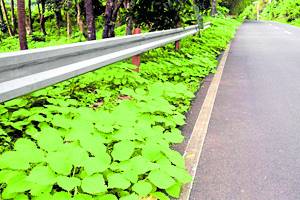‘Pest’ plant finds use in paper conservation

‘GOOD SUBSTITUTE’ Photo shows a conservator testing a “lapnis” hand made paper on a fragile document. —PHOTOS BY THE DEPARTMENT OF SCIENCE AND TECHNOLOGY’S FOREST PRODUCTS RESEARCH AND DEVELOPMENT INSTITUTE AND PHILIPPINE COUNCIL FOR AGRICULTURE, AQUATIC, AND NATURAL RESOURCES RESEARCH AND DEVELOPMENT
MANILA, Philippines — Scientists of the Department of Science and Technology (DOST) are exploring another use for paper mulberry, the invasive plant species locally known as “lapnis,” apart from its benefits as a source of medicine and fiber.
“Our initial research showed that lapnis’ strength and long fibers make it a good substitute for imported conservation paper,” said Cesar Austria, the project leader from the Forest Products Research and Development Institute (FPRDI) of the DOST.
According to Austria, handmade paper from lapnis (Broussonetia papyrifera (L.) L’Herit ex Vent) is best used in paper conservation, which is the process of restoring and preserving a wide range of valuable paper-based objects, including rare books and even images drawn or printed on paper.
Handmade paper from lapnis was found to be strong, insect and tear-resistant, acid-free and translucent—characteristics of good conservation paper, Austria said.
Last year, the FPRDI completed its study seeking to assess the coppicing of lapnis. This is the practice of cutting trees or plants to further stimulate their growth.
Eventually five different kinds of handmade papers were developed from that research and were evaluated by a conservator.

Paper mulberry shrubs are seen at a roadside on the way to Mt. Makiling in Los Baños, Laguna province.
Top importer
Austria said developing paper from lapnis may reduce the country’s dependence on importing these kinds of materials.
Based on World Bank data in 2019, the Philippines was 27th out of 146 top importers of handmade paper and paperboard products at 386 tons, worth $509,000.
These products were shipped from the United States, China, Australia, Turkey, Japan and Thailand.
Austria said there would be further studies at the FPRDI to improve the lapnis paper’s color, fiber formation and distribution, and clarity—its being free from specks, dirt and other foreign particles.
The Institute also offers training on lapnis handmade paper production. Inquiries may be emailed to its Training and Manpower Delivery Services Section via [email protected].
Lapnis, which is native to East Asian countries such as China, Japan and Korea, can be classified as a large shrub or a small tree, growing from 10 to 20 meters, with a soft and brittle wood. Its timber has little or no commercial value other than for papermaking.
Its parts are known for having medicinal benefits. The leaves are used as a laxative, the bark, to treat dysentery and hemorrhage, and the fruits made into a tonic. The sap is applied to eczema, bee stings and bites from snakes and dogs.
Alien plant
Lapnis was introduced to the country in 1935 as part of a reforestation program to augment the bast fiber-producing tree crops at the Makiling Forestry School campus in Laguna province.
Over the years, however, lapnis had come to be known as a “pest”—thriving uncontrollably, especially in the Mt. Makiling Forest Reservation, where it badly affected the growth of other flora.
The Department of Environment and Natural Resources listed lapnis among the invasive alien plants “as it invades young secondary forests and retards the natural ecological succession in forest gaps.”But in 2017, the DOST’s Philippine Council for Agriculture, Aquatic and Natural Resources Research and Development funded a study on lapnis to find ways to control its spread.
Based on its trials, the FPRDI was able to produce charcoal, briquettes, handmade paper and light-load bearing furniture that passed quality standards from lapnis wood.
“We want to help control the continued spread of paper mulberry in the country, not by killing off the shrubs but by finding possible uses for their wood,” said FPRDI scientist Pablito Alcachupas, the project leader of an earlier study by the Institute.
He added: “The long-term goal is to be able to establish well-managed paper mulberry plantations in the future.”














